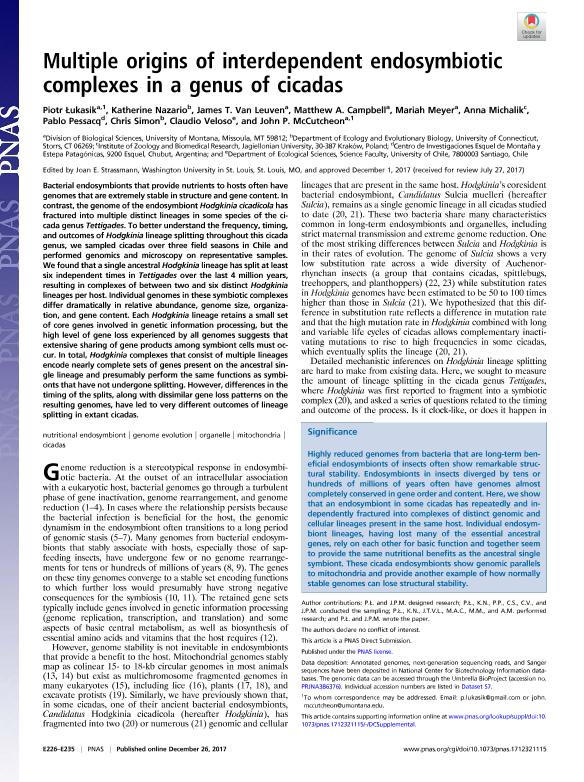Mostrar el registro sencillo del ítem
dc.contributor.author
Lukasik, Piotr
dc.contributor.author
Nazario, Katherine
dc.contributor.author
Van Leuven, James T.
dc.contributor.author
Campbell, Matthew A.
dc.contributor.author
Meyer, Mariah
dc.contributor.author
Michalik, Anna
dc.contributor.author
Pessacq, Pablo

dc.contributor.author
Simon, Chris
dc.contributor.author
Veloso, Claudio
dc.contributor.author
McCutcheon, John P.
dc.date.available
2018-08-22T18:54:37Z
dc.date.issued
2017-01
dc.identifier.citation
Lukasik, Piotr; Nazario, Katherine; Van Leuven, James T.; Campbell, Matthew A.; Meyer, Mariah; et al.; Multiple origins of interdependent endosymbiotic complexes in a genus of cicadas; National Academy of Sciences; Proceedings of the National Academy of Sciences of The United States of America; 115; 2; 1-2017; E226-E235
dc.identifier.issn
0027-8424
dc.identifier.uri
http://hdl.handle.net/11336/56661
dc.description.abstract
Bacterial endosymbionts that provide nutrients to hosts often have genomes that are extremely stable in structure and gene content. In contrast, the genome of the endosymbiont Hodgkinia cicadicola has fractured into multiple distinct lineages in some species of the cicada genus Tettigades. To better understand the frequency, timing, and outcomes of Hodgkinia lineage splitting throughout this cicada genus, we sampled cicadas over three field seasons in Chile and performed genomics and microscopy on representative samples. We found that a single ancestral Hodgkinia lineage has split at least six independent times in Tettigades over the last 4 million years, resulting in complexes of between two and six distinct Hodgkinia lineages per host. Individual genomes in these symbiotic complexes differ dramatically in relative abundance, genome size, organization, and gene content. Each Hodgkinia lineage retains a small set of core genes involved in genetic information processing, but the high level of gene loss experienced by all genomes suggests that extensive sharing of gene products among symbiont cells must occur. In total, Hodgkinia complexes that consist of multiple lineages encode nearly complete sets of genes present on the ancestral single lineage and presumably perform the same functions as symbionts that have not undergone splitting. However, differences in the timing of the splits, along with dissimilar gene loss patterns on the resulting genomes, have led to very different outcomes of lineage splitting in extant cicadas.
dc.format
application/pdf
dc.language.iso
eng
dc.publisher
National Academy of Sciences

dc.rights
info:eu-repo/semantics/openAccess
dc.rights.uri
https://creativecommons.org/licenses/by-nc-sa/2.5/ar/
dc.subject
Cicadas
dc.subject
Genome Evolution
dc.subject
Mitochondria
dc.subject
Nutritional Endosymbiont
dc.subject
Organelle
dc.subject.classification
Otras Ciencias Biológicas

dc.subject.classification
Ciencias Biológicas

dc.subject.classification
CIENCIAS NATURALES Y EXACTAS

dc.title
Multiple origins of interdependent endosymbiotic complexes in a genus of cicadas
dc.type
info:eu-repo/semantics/article
dc.type
info:ar-repo/semantics/artículo
dc.type
info:eu-repo/semantics/publishedVersion
dc.date.updated
2018-08-21T12:57:19Z
dc.journal.volume
115
dc.journal.number
2
dc.journal.pagination
E226-E235
dc.journal.pais
Estados Unidos

dc.journal.ciudad
Washington
dc.description.fil
Fil: Lukasik, Piotr. University of Montana; Estados Unidos
dc.description.fil
Fil: Nazario, Katherine. University of Connecticut; Estados Unidos
dc.description.fil
Fil: Van Leuven, James T.. University of Montana; Estados Unidos
dc.description.fil
Fil: Campbell, Matthew A.. University of Montana; Estados Unidos
dc.description.fil
Fil: Meyer, Mariah. University of Montana; Estados Unidos
dc.description.fil
Fil: Michalik, Anna. Jagiellonian University; Polonia
dc.description.fil
Fil: Pessacq, Pablo. Consejo Nacional de Investigaciones Científicas y Técnicas. Centro Científico Tecnológico Conicet - Patagonia Norte. Centro de Investigación Esquel de Montaña y Estepa Patagóica. Universidad Nacional de la Patagonia "San Juan Bosco". Facultad de Ciencias Naturales - Sede Esquel. Centro de Investigación Esquel de Montaña y Estepa Patagónica; Argentina
dc.description.fil
Fil: Simon, Chris. University of Connecticut; Estados Unidos
dc.description.fil
Fil: Veloso, Claudio. Universidad de Chile; Chile
dc.description.fil
Fil: McCutcheon, John P.. University of Montana; Estados Unidos
dc.journal.title
Proceedings of the National Academy of Sciences of The United States of America

dc.relation.alternativeid
info:eu-repo/semantics/altIdentifier/doi/https://dx.doi.org/10.1073/pnas.1712321115
dc.relation.alternativeid
info:eu-repo/semantics/altIdentifier/url/http://www.pnas.org/content/115/2/E226
Archivos asociados
